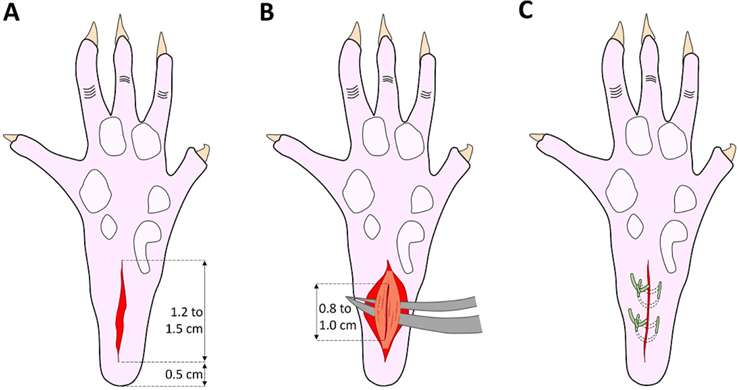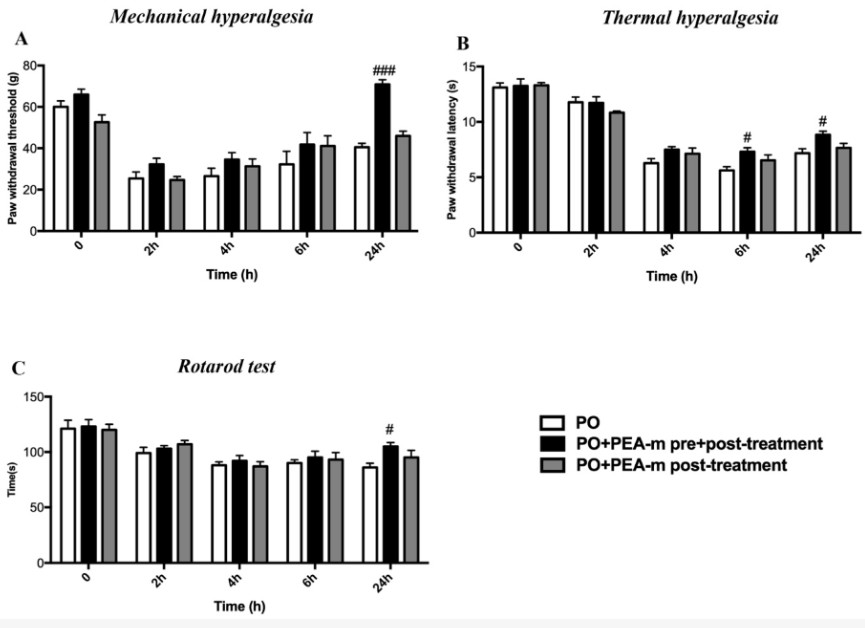- You are here: Home
- Disease Models
- Pain Models
- Postoperative Pain (POP) Model
Disease Models
- Oncology Models
-
Inflammation & Autoimmune Disease Models
- Rheumatoid Arthritis Models
- Glomerulonephritis Models
- Multiple Sclerosis (MS) Models
- Ocular Inflammation Models
- Sjögren's Syndrome Model
- LPS-induced Acute Lung Injury Model
- Peritonitis Models
- Passive Cutaneous Anaphylaxis Model
- Delayed-Type Hypersensitivity (DTH) Models
- Inflammatory Bowel Disease Models
- Systemic Lupus Erythematosus Animal Models
- Asthma Model
- Sepsis Model
- Psoriasis Model
- Atopic Dermatitis (AD) Model
- Scleroderma Model
- Gouty Arthritis Model
- Carrageenan-Induced Air Pouch Synovitis Model
- Carrageenan-Induced Paw Edema Model
- Experimental Autoimmune Myasthenia Gravis (EAMG) Model
-
Cardiovascular Disease Models
- Surgical Models
- Animal Models of Hypertension
- Venous Thrombosis Model
- Atherosclerosis model
- Cardiac Arrhythmia Model
- Hyperlipoidemia Model
- Doxorubicin-induced Heart Failure Model
- Isoproterenol-induced Heart Failure Model
- Arterial Thrombosis Model
- Pulmonary Arterial Hypertension (PAH) Models
- Heart Failure with Preserved Ejection Fraction (HFpEF) Model
-
Neurological Disease Models
- Alzheimer's Disease Modeling and Assays
- Seizure Models
- Parkinson's Disease Models
- Ischemic Stroke Models
- Acute Spinal Cord Injury (ASCI) Model
- Traumatic Brain Injury (TBI) Model
- Hypoxic-Ischemic Encephalopathy (HIE) Model
- Tourette Syndrome (TS) Model
- Amyotrophic Lateral Sclerosis (ALS) Model
- Huntington's Disease (HD) Model
- Intracerebral hemorrhage (ICH) Models
- Pain Models
- Metabolic Disease Models
- Liver Disease Models
- Rare Disease Models
- Respiratory Disease Models
- Digestive Disease Models
-
Urology Disease Models
- Cisplatin-induced Nephrotoxicity Model
- Unilateral Ureteral Obstruction Model
- 5/6 Nephrectomy Model
- Renal Ischemia-Reperfusion Injury (RIRI) Model
- Diabetic Nephropathy (DN) Models
- Passive Heymann Nephritis (PHN) Model
- Adenine-Induced Chronic Kidney Disease (CKD) Model
- Kidney Stone Model
- Doxorubicin-Induced Nephropathy Model
- Orthopedic Disease Models
- Ocular Disease Models
- Skin Disease Models
- Infectious Disease Models
Postoperative Pain (POP) Model
If you are looking for a reliable partner to help you evaluate the efficacy of your drug candidates within the postoperative pain (POP) model, look no further than Creative Bioarray. We have meticulously established what is now recognized as the gold standard model for POP. By leveraging our state-of-the-art services, you can significantly expedite your drug development journey.
Managing postoperative pain presents a significant challenge for both clinicians and patients alike. When postoperative pain remains unaddressed, it not only causes considerable suffering and discomfort but also fosters psychological and pathophysiological hurdles. Despite the availability of therapeutic agents and analgesic techniques, a substantial number of patients still experience moderate to severe pain post-surgery. This underscores the critical need for ongoing research into effective analgesic treatments for postoperative pain.
At the preclinical level, the Brennan Model, also known as incisional pain model, is recognized as the gold standard for studying postoperative pain. This model enables the measurement of nociceptive behaviors following an incisional procedure, with the Von Frey test being a notable method. After a plantar incision, the withdrawal threshold in response to progressive pressure application is significantly reduced, and the resulting mechanical allodynia persists for several days. The incisional pain model is invaluable for exploring the mechanisms behind increased mechanical sensitivity post-surgery and is extensively employed to evaluate the efficacy of novel analgesics in the context of postoperative pain.
Our Postoperative Pain (POP) Model
- Available Animal
Rat
- Modeling Method
After anesthetization, carefully make a longitudinal incision through both the skin and fascia. Use forceps to gently spread the skin away from the underlying flexor digitorum brevis muscle. Then, make a longitudinal incision with the scalpel through the entire belly of the muscle. Finally, close the wound by putting two sutures in the skin.
 Fig. 1 Schematic diagram of the establishment of postoperative pain model. (A) Longitudinal skin incision, (B) Isolation, elevation, and incision of the plantaris muscle, (C) Two horizontal mattress sutures close the skin. (Brennan et al. 1996.)
Fig. 1 Schematic diagram of the establishment of postoperative pain model. (A) Longitudinal skin incision, (B) Isolation, elevation, and incision of the plantaris muscle, (C) Two horizontal mattress sutures close the skin. (Brennan et al. 1996.)
- Endpoints
- Clinical observation
- Behavioral tests: mechanical hyperalgesia (Von frey test), thermal hyperalgesia (Hot plate test)
- Histology analysis
- qPCR or Western blot
- Other customized endpoints
Example Data
 Fig. 2 Effects of micronized palmitoylethanolamide (PEA-m) on mechanical allodynia, thermal hyperalgesia, and motor coordination after postoperative pain (PO). (Siracusa et al. 2020)
Fig. 2 Effects of micronized palmitoylethanolamide (PEA-m) on mechanical allodynia, thermal hyperalgesia, and motor coordination after postoperative pain (PO). (Siracusa et al. 2020)
In addition, we also provide other pain models that maybe you are interested in:
Quotation and Ordering
Creative Bioarray boasts extensive expertise in assessing the efficacy of different drugs across a diverse array of disease models. Our commitment is to offer clients swiftly arranged, economical services that adhere to the utmost standards of quality and precision. If you are interested in our services, please feel free to contact us at any time or submit an inquiry to us directly.
References
- Siracusa, R., et al. The protective effects of pre-and post-administration of micronized palmitoylethanolamide formulation on postoperative pain in rats. International Journal of Molecular Sciences, 2020, 21(20): 7700.
- Brennan, T.J., et al. Characterization of a rat model of incisional pain. Pain, 1996, 64(3): 493-502.
For research use only. Not for any other purpose.

